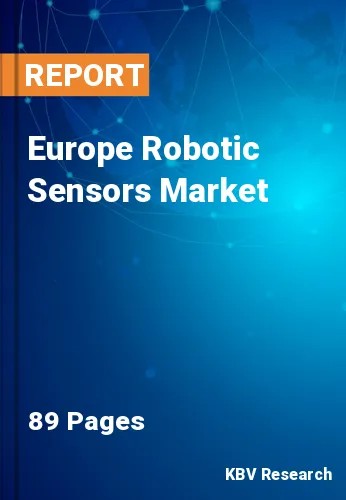The Europe Robotic Sensors Market would witness market growth of 9.8% CAGR during the forecast period (2022-2028).
Without making physical touch, proximity sensors could identify the existence of an object over a certain range. In addition, a proximity sensor operates on a straightforward concept. A receiver collects and checks the return signal for disruptions after a transmitter sends electromagnetic radiation or generates an electric field.
The angular location of a shaft or wheel is converted into an analog or digital code using encoder sensors, which are not technically sensors but rather a mix of many components. The common type of encoder has an optical disc that rotates, a light detector, and a light source. The rotating disc has a colored or imprinted transparent & opaque pattern on it, or just a black & white pattern. The light that is being emitted is broken when the disc spins with the wheel, producing an output signal. The distance measured by the robot could be calculated using the frequency of the interruptions and the diameter of the wheel.
Force sensors could assist robots’ function better overall, but they could also assist protect workers' safety. Robotic injury can be avoided using force sensors that control the amount of force used. Because of this, they are a common feature of several collaborative robot models and help explain why cobots can work alongside people. Force sensors could identify when an inappropriate force is delivered to the robot arm in addition to determining how much pressure to apply when working. Collaborative robots are warned to slow down or stop operating altogether to avoid negative accidents and protect workers when anomalous force is recognized.
Germany is the fifth-largest robot market in the world, with about 20,000 industrial robots in use across a variety of industries. The main industries that use them include transportation, metalworking, electrical & electronics, chemical rubber and plastic products, logistics, medicine, and the food industry. The OPC Foundation (Open Platform Communications) collaborates with the German Mechanical Engineering Industry Association (VDMA).
In order to create a worldwide standards regime built on the OPC UA Machine Vision Companion Specification, such two parties entered into a partnership in June 2016. The machine protocol was developed to let all automation companies use robotics, automation, and machine vision software to include Industry 4.0/IoT in their products.
The Germany market dominated the Europe Robotic Sensors Market by Country in 2021, and would continue to be a dominant market till 2028; thereby, achieving a market value of $203.2 million by 2028. The UK market is anticipated to grow at a CAGR of 8.9% during (2022 - 2028). Additionally, The France market would exhibit a CAGR of 10.6% during (2022 - 2028).
Based on Vertical, the market is segmented into Manufacturing, Logistics, Aerospace & Defense, Healthcare, and Others. Based on Type, the market is segmented into Force (Torque) Sensor, Proximity Sensor, Position Sensor, Vision Sensor, Temperature Sensor, and Others. The report also covers geographical segmentation of Robotic Sensors market. Based on countries, the market is segmented into Germany, UK, France, Russia, Spain, Italy, and Rest of Europe.
Free Valuable Insights: The Global Robotic Sensors Market will Hit $3.1 Billion by 2028, at a CAGR of 10.2%
The market research report covers the analysis of key stake holders of the market. Key companies profiled in the report include TE Connectivity Ltd., Infineon Technologies AG, Omron Corporation, Honeywell International, Inc., ATI Industrial Automation, Inc., FANUC Corporation, Sensata Technologies Holdings PLC, Baumer Holding AG, Tekscan, Inc., and FUTEK Advanced Sensor Technology, Inc.
By Vertical
By Type
By Country
Our team of dedicated experts can provide you with attractive expansion opportunities for your business.

